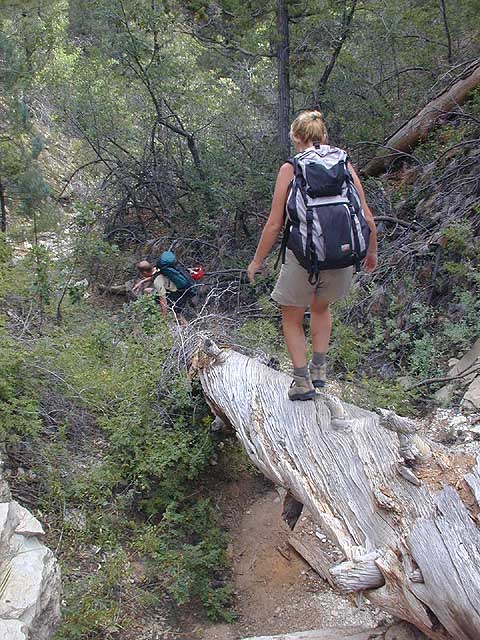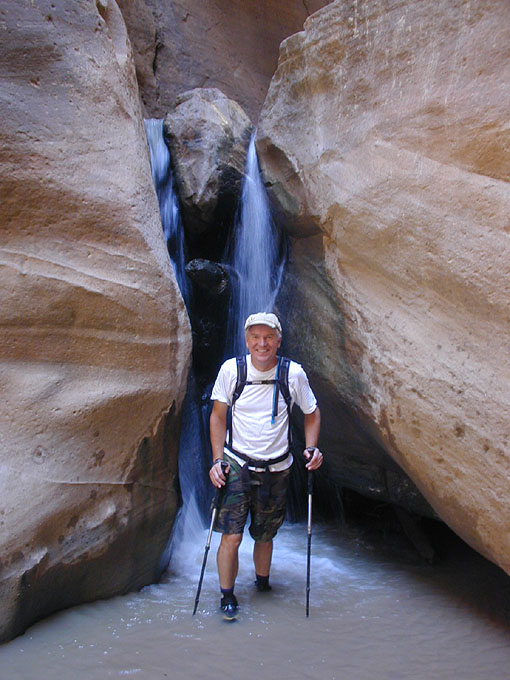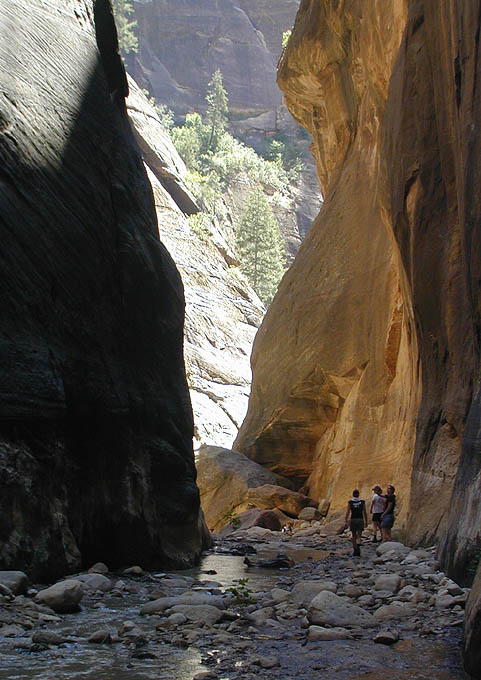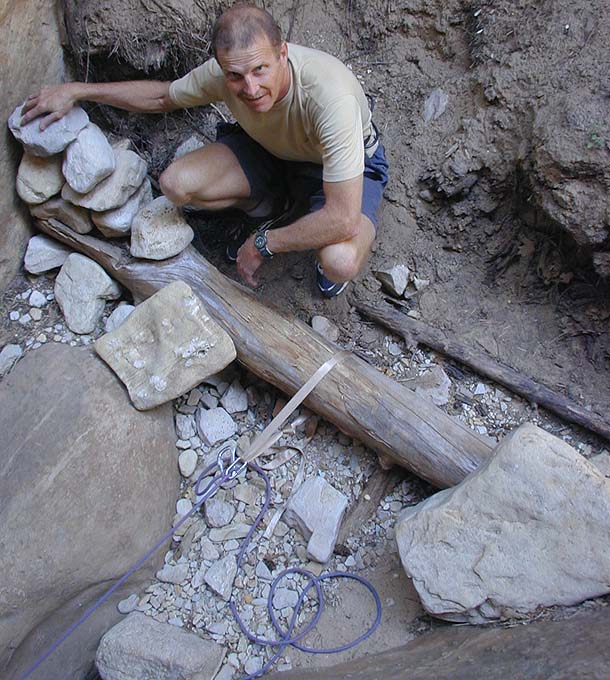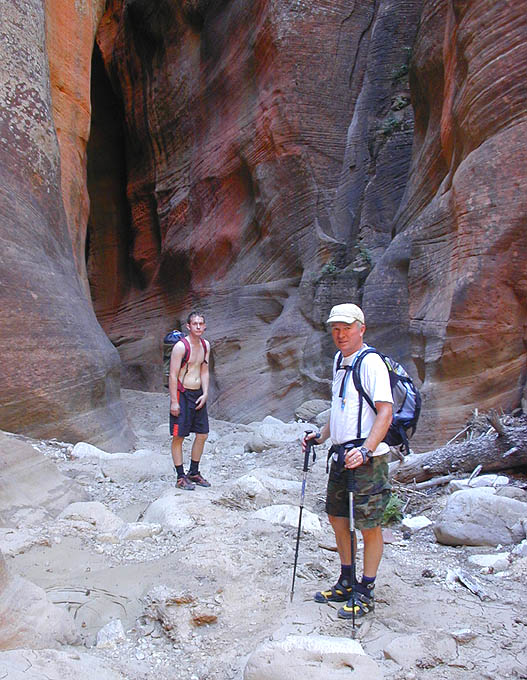Englestead Canyon and Natural Anchors, Zion National Park, UT
On this occasion, we were descending Englestead with several southern Utah locals. Mark "Little Bear" Mallory had invited us down since he had a rope fixed for the first drop. He has also invited Bo Beck from the Zion SAR team, who brought along a newly-arrived, enthusiastic Park seasonal employee. Scott and I rounded out the group, having driven down from Salt Lake the day before. Our little group rendezvoused at Canyon Junction and sorted out cars.
A hearty breakfast begins a day in the canyon. (Englestead)
Kip had scouted out a different way to get into the canyon, and encouraged us to check it out. Hmmmm. The driving was easier, but the route crosses some steep loose slopes and has a bit of nasty bushwhacking. The steep, loose slopes would tear up pretty quickly if this route became popular, so in the interest of minimizing impacts, the "normal" route in is better. (Englestead)
A “natural” anchor in lower Englestead.
Constructed anchors like this are controversial. Is this really a stout enough anchor for the troops of beginners that descend this canyon? Is an obviously constructed anchor like this really less obtrusive than a few discreet bolts?
Opinions vary.
Personally, I like to use the 2-ton log about 30 feet up-canyon, that can be used without a sling. But - people tend to look for an anchor within spitting distance of the top of the drop, so the 2-ton tree does not enter into people's consideration (even though it works just fine). I suppose some people find the stabilized log (shown) more of an intrusion than bolts, but I don't. At least it is made of natural materials, and can be deconstructed in a couple of minutes. And will be by a good flood down this canyon.
Is it safe? I think we all can agree that people should not rappel off things they don't feel are safe. My concern is that this leads to a lowest-common-denominator effect - that even pretty solid and easy to use natural (and constructed anchors) are rejected by a segment of the canyoneering community who do not have an aversion to bolts, and the result is bolts springing up next to pretty decent natural anchors. Eventually all the drops in the Trade Route canyons will be bolted, and beginners will become intermediates without even so much as seeing a natural anchor. It is a useful canyoneering skill to be able to build "natural" anchors from materials at hand in the canyon, and to be able evaluate their quality.
So how does one develop a sense of what these "dicey" anchors can hold? Practice, testing, cross-pollination. Even anchors that look pretty solid should be backed up for the first couple of people down. Anchors should be tested, using belays and back-ups to make the testing process "safe". Cross-pollination means going out with people that have different skills than you have, and listening to what they have to say. All of us have a tendency to canyoneer with our own little cliques, and think that our style and knowledge is "best". Getting out with more people tends to give one a less parochial viewpoint.
But wouldn't a couple bolts make all this a moot point? And what's the problem with that?
It is the easy solution for sure - slam in a couple of bolts. And for some people, there is no problem. For some of us, there is. By "solving" every problem with bolts, what are we teaching the aspiring intermediate canyoneers who are the main descenders of this canyon? Rather than tell them "just bolt it", is it not better to demonstrate natural anchor techniques that they can then have for their toolbox, for later descents in later canyons, when they might not have a bolt kit? Five years from now, will every 3 foot drop in Zion sport a bolt anchor - because they are "safer"?
There are places where bolts are appropriate for reducing canyoneer impact, no question. Repeated rappels off of small trees tends to kill them - not good. Visible anchors in specific places can "encourage" people to stay in the watercourse and not cut trails around short drops. Long slings, buried or tied off to chunks of wood upcanyon, are not only unsightly, but their position makes them unlikely to be inspected more than once in a long while. Dangerous.
Safe? Some people claim bolts are much "safer". Well, there is some justification for that - there has been one natural anchor failure in Zion that resulted in a fatality, and zero bolt failure deaths. There really aren't many anchor failures in Zion. Perhaps my concern about the weakness of bolts placed in Zion is due to my over-active imagination, but they sure scare me! Bolts are difficult to place well in the soft, poorly cemented sandstone of Zion. It takes quite a bit of skill, yet many bolts are placed by the unskilled. How do you tell whether the bolt you are about to trust your life to is solid and reliable? Uh, well, bolts are really hard to inspect. You just don't know. You are basically just guessing that the bolt or bolts were placed reasonably well.
Summary: lots of gray area here. Pretty good arguments can be made either way. Everyone should and will develop their own opinion. I hope people will take the time and enjoy the challenge of developing their natural anchor skills. It helps to talk with a variety of people, not just your own friends. Chopping bolts (like I have done) does not help. Placing bolts where there are solid natural anchors easily available also does not help.
OK, off soap-box and on with the trip report...
We do the usual downclimbs, short raps etc. and arrive in Orderville. We are thankful we have been immersed in the depths of Englestead, escaping the searing heat of August in Zion.
So here’s some pictures of Orderville.
Second “Rappel” in Orderville. With the mud and all, the downclimb tends to be polished and muddy, and goes down to some very, very slippery slanted logs, above a pool of indeterminate depth. We usually use a rope here as a handline.
Shortly after this, we ran into the “day-hiker” crowd in Orderville.
Are these canyons crowded? Again opinions vary, and I won't subject you to another lecture. One thing I like about being in the canyons is that if you feel crowded, you can just put on a burst of speed, or stop and have lunch, and by putting a couple hundred yards between you and other parties, have the canyon to yourself, pretty much.
A downclimb in Orderville. A little assistance helps the less-experienced members of the party surpass the obstacle at a higher level of comfort.
Working our way through some small, wet narrows. Orderville has filled in with sand and mud, and there are no swims at the moment.
Hiking out the final, high, spectacular narrows.
How do you know when you get to The Narrows?



